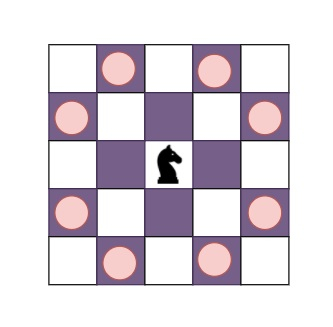使用Python编写一个程序,找出棋子到达棋盘上每个位置所需的最少移动次数
假设我们有一个棋盘和一个特殊的骑士棋子K,它在棋盘上以“L”型移动。如果棋子在位置(x1,y1),并向(x2,y2)移动,则其移动可以描述为x2 = x1 ± a; y2 = y1 ± b或x2 = x1 ± b; y2 = y1 ± a; 其中a和b是整数。我们必须找出棋子从位置(0,0)到达棋盘上位置(n-1,n-1)所需的最小移动次数。如果位置无法到达,则标记为-1,否则将返回移动次数。我们将输出n-1行,其中每行i包含描述棋子必须进行的每个j的最小移动次数的n-1个整数。
因此,如果输入为n = 6,则输出将为

5 4 3 2 5
4 -1 2 -1 -1
3 2 -1 -1 -1
2 -1 -1 -1 -1
5 -1 -1 -1 1
如果骑士处于5×5的棋盘的位置(3,3),则它的可行移动范围如上图所示。
输出的第一行包含棋子到达位置(1,1)到(1,5)所需的最小移动次数。后续行类似地描述了其各自的i和j值的最小移动次数。
源代码(Python)
让我们看下面的实现以更好地理解-
from collections import defaultdict
def path_search(i, j, n):
temp_list = defaultdict(lambda: (-1,-1))
queue_positional = [(0, 0)]
ver = [(i, j), (-i, j), (i, -j), (-i, -j), (j, i), (j, -i), (-j, i), (-j, -i)]
while len(queue_positional) > 0:
current_element = queue_positional.pop(0)
for element in ver:
x = element[0] + current_element[0]
y = element[1] + current_element[1]
if -1 < x < n and -1 < y < n and temp_list[x, y] == (-1,-1):
temp_list[x, y] = current_element
queue_positional.append((x, y))
if x == n - 1 and y == n - 1:
count_var = 1
while temp_list[x,y]!=(0,0):
count_var += 1
x, y = temp_list[x,y]
return count_var
return -1
def solve(n):
board = defaultdict(lambda: -1)
for i in range(1, n):
for j in range(1, i):
if board[i, j] == -1:
board[i, j] = path_search(i, j, n)
board[j, i] = board[i, j]
if (n - 1) % i == 0:
board[i, i] = (n - 1) / i
for i in range(1, n):
for j in range(1, n - 1):
print(int(board[i, j]), end = ' ')
print(int(board[i, n - 1]))
solve(6)
输入
“`python 6“`
输出
“`python 5 4 3 2 5
4 -1 2 -1 -1
3 2 -1 -1 -1
2 -1 -1 -1 -1
5 -1 -1 -1 1
“`
 极客教程
极客教程